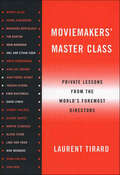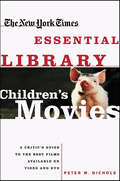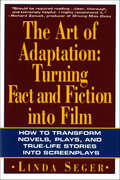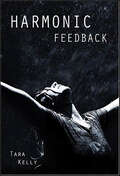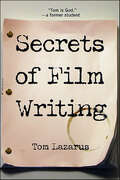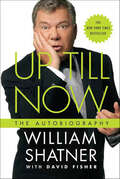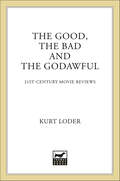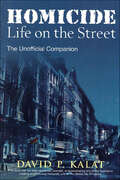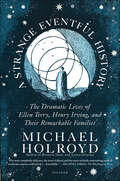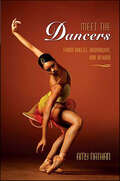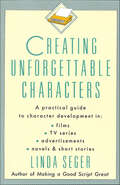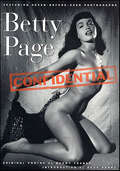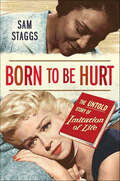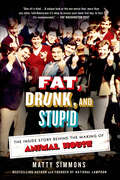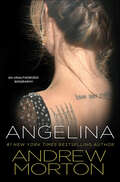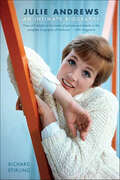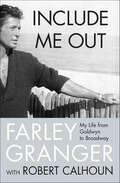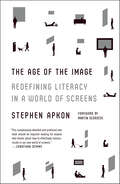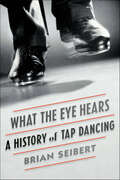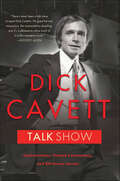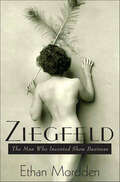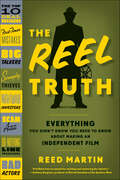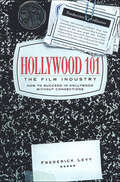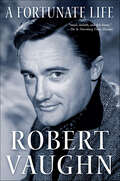- Table View
- List View
Moviemakers' Master Class: Private Lessons from the World's Foremost Directors
by Laurent TirardInterviews with Scorsese, Lynch, Godard, Woo, the Coen brothers, and more of the world’s greatest directors on how they make films—and why.Every great filmmaker has a secret method to his moviemaking—but each of them is different. In Moviemaker Master Class, Laurent Tirard talks to twenty of our era’s most important filmmakers to get to the core of each director’s approach to film, exploring the filmmaker’s vision as well as his technique, while allowing each to speak in his own voice.Martin Scorsese likes setting up each shot very precisely ahead of time—so that he has the opportunity to change it all if he sees the need. Lars Von Trier, on the other hand, refuses to think about a shot until the actual moment of filming. And Bernardo Bertolucci tries to dream his shots the night before; if that doesn’t work, he roams the set alone with a viewfinder, imagining the scene before the actors and crew join him. In these interviews with David Cronenberg, Pedro Almodovar, Tim Burton, Wim Wenders, and more—which originally appeared in the French film magazine Studio and are being published here in English for the first time—enhanced by exceptional photographs of the directors at work, Laurent Tirard has succeeded in finding out what makes each filmmaker, and his films, so extraordinary, shedding light on both the process and the people behind great moviemaking.“Tirard’s healthy balance of nuts-and-bolts information and conceptual musings should be of interest to lay readers as well as would-be auteurs.” —Publishers Weekly“[An] excellent resource.” —Library Journal
The New York Times Essential Library: Children's Movies (The New York Times Essential Library)
by Peter M. NicholsAn indispensable guide for parents from a leading expert on children's filmFor years Peter M. Nichols has been offering vital advice and information for parents about current movies in his regular "Taking the Children" column. But parents need the same kind of guidance when renting or buying videos and DVDs for their family. They may know that movies such as Toy Story and Chicken Run are good choices for their children, but Nichols helps parents go beyond the obvious choices to more unconventional movies like The African Queen and Some Like It Hot. From the classics of animation to a host of great comedies and dramas, Nichols provides a knowing and illuminating guide to one hundred great cinematic works.Each brief original essay not only explains why the children will enjoy the film but also allows Nichols to offer timely bits of film history and to discuss certain films in a larger cultural context. Nichols's knowledge and understanding of films is broad and deep, and many of his choices-especially of films that we might not have thought of as "children's films"-will surprise and delight readers.
The Art of Adaptation: Turning Fact and Fiction into Film
by Linda SegerAdaptations have long been a mainstay of Hollywood and the television networks. Indeed, most Academy Award- and Emmy Award-winning films have been adaptations of novels, plays, or true-life stories. Linda Seger, author of two acclaimed books on scriptwriting, now offers a comprehensive handbook for screenwriters, producers, and directors who want to successfully transform fictional or factual material into film. Seger tells how to analyze source material to understand why some of it resists adaptation. She then gives practical methods for translating story, characters, themes, and style into film. A final section details essential information on how to adapt material and how to protect oneself legally.
Harmonic Feedback
by Tara KellySixteen-year-old, music- and sound design-obsessed Drea doesn't have friends. She has, as she's often reminded, issues. Drea's mom and a rotating band of psychiatrists have settled on "a touch of Asperger's."Having just moved to the latest in a string of new towns, Drea meets two other outsiders. And Naomi and Justin seem to actually like Drea. The three of them form a band after an impromptu, Portishead-comparison-worthy jam after school. Justin swiftly challenges not only Drea's preference for Poe over Black Lab but also her perceived inability to connect with another person. Justin, against all odds, may even like like Drea. It's obvious that Drea can't hide behind her sound equipment anymore. But just when she's found not one but two true friends, can she stand to lose one of them?Harmonic Feedback is a 2011 Bank Street - Best Children's Book of the Year.
Considering Doris Day: A Biography
by Tom SantopietroThe biggest female box office attraction in Hollywood history, Doris Day remains unequalled as the only entertainer who has ever triumphed in movies, radio, recordings, and a multi-year weekly television series. America's favorite girl next door may have projected a wholesome image that led Oscar Levant to quip "I knew Doris Day before she was a virgin," but in Considering Doris Day Tom Santopietro reveals Day's underappreciated and effortless acting and singing range that ran the gamut from musicals to comedy to drama and made Day nothing short of a worldwide icon. Covering the early Warner Brothers years through Day's triumphs working with artists as varied as Alfred Hitchcock and Bob Fosse, Santopietro's smart and funny book deconstructs the myth of Day as America's perennial virgin, and reveals why her work continues to resonate today, both onscreen as pioneering independent career woman role model, and off, as a recipient of the Presidential Medal of Freedom, the United States' highest civilian honor. Praised by James Cagney as "my idea of a great actor" and by James Garner as "the Fred Astaire of comedy," Doris Day became not just America's favorite girl, but the number one film star in the world. Yet after two weekly television series, including a triumphant five year run on CBS, she turned her back on show business forever. Examining why Day's worldwide success in movies overshadowed the brilliant series of concept recordings she made for Columbia Records in the '50s and '60s, Tom Santopietro uncovers the unexpected facets of Day's surprisingly sexy acting and singing style that led no less an observer than John Updike to state "She just glowed for me." Placing Day's work within the social context of America in the second half of the twentieth century, Considering Doris Day is the first book that grants Doris Day her rightful place as a singular American artist.
Secrets of Film Writing
by Tom LazarusMost books about screenplays instruct on three-act structure, character arcs, and how to format a script. But you already know all that.Secrets of Film Writing reveals a working writer's secrets-the tips, short cuts, tricks, and insider advice that will get your story down on paper, maximize your idea, and seduce your readers. Do you know why actors pick scripts out of a stack? Why montage sequences don't work? Why the traditional three-act structure is obsolete? Lazarus lifts the veil with dozens of secrets like these.Lazarus's insights and techniques will smooth and improve any screenwriter's process and will make any script more readable and ultimately more salable. Secrets of Film Writing takes you behind the scenes of feature and television writing and demystifies, once and for all, the Hollywood System.
Up Till Now: The Autobiography
by William Shatner David FisherAfter almost sixty years as an actor, William Shatner has become one of the most beloved entertainers in the world. And it seems as if Shatner is everywhere. In Up Till Now, Shatner sits down with readers and offers the remarkable, full story of his life and explains how he got to be, well, everywhere. It was the original Star Trek series, and later its films, that made Shatner instantly recognizable, called by name---or at least by Captain Kirk's name---across the globe. But Shatner neither began nor has ended his career with that role. From the very start, he took his skills as an actor and put them to use wherever he could. He straddled the classic world of the theater and the new world of television, whether stepping in for Christopher Plummer in Shakespeare's Henry V or staring at "something on the wing" in a classic episode of The Twilight Zone. And since then, he's gone on to star in numerous successful shows, such as T.J. Hooker,Rescue 911, and Boston Legal. William Shatner has always been willing to take risks for his art. What other actor would star in history's first---and probably only---all-Esperanto-language film? Who else would share the screen with thousands of tarantulas, release an album called Has Been, or film a racially incendiary film in the Deep South during the height of the civil rights era? And who else would willingly paramotor into a field of waiting fans armed with paintball guns, all waiting for a chance to stun Captain...er, Shatner?In this touching and very funny autobiography, William Shatner's Up Till Now reveals the man behind these unforgettable moments, and how he's become the worldwide star and experienced actor he is today."It is now Bill Shatner's universe---we just live in it."---New York Daily News
The Good, the Bad, and the Godawful: 21st-Century Movie Reviews
by Kurt LoderThe former Rolling Stone writer and MTV host takes off from classic Roger Ebert and sails boldly into the new millennium.Millions grew up reading the author's record reviews and watching him on MTV's "The Week in Rock." In this collection of more than 200 movie reviews from MTV.com and, more recently, the Reason magazine Website, plus sidebars exclusive to this volume, Loder demonstrates his characteristic wry voice and finely honed observations. The author shines when writing on the best that Hollywood and indie filmmakers have to offer, and his negative reviews are sometimes more fun than his raves. This freewheeling survey of the wild, the wonderful and the altogether otherwise is an indispensable book for any film buff.
Homicide: Life on the Streets—The Unofficial Companion
by David P. KalatIntelligent writing, intense characters, a dark sense of humor, innovative editing, and complex plots--Homicide: Life on the Street has raised the caliber of television police dramaHomicide: Life on the Street is addictive television. Each week we watch to see who Detective Pembleton will spar with in "the Box," or what conspiracy theories Detective Munch will be espousing as the truth, but more than anything we tune in to see the gritty reality that makes this show the best police drama to ever grace the small screen. There aren't any car chases, rarely any shootouts, and sometimes the cases don't get solved. Instead, these detectives keep their clothes on, have a relentlessly morbid sense of humor, and catch the criminals because they have brains, not necessarily brawn. In other words, they're real.Homicide: Life on the Street, The Unofficial Companion by David P. Kalat--the first and only full-length guide to this Emmy Award-winning and three-time Peabody Award-winning television series--brilliantly captures the essence of this groundbreaking show.You'll Learn About:famed filmmaker Barry Levinson's decision to bring Homicide to television instead of making a film of David Simon's novel Homicide: A Year on the Killing Streetsthe behind-the-scenes anecdotes about cast regulars, including the onscreen clutches that led to offscreen romancesthe producers' many battles with the network suits over poor placement in the schedule, and the series' repeated trips to the land known as hiatuscast casualties--why they left or were let gothe esteemed cast--including Andre Braugher, Ned Beatty, Daniel Baldwin, and Yaphet Kotto, among others--the characters they've created, and their beyond-Homicide careersseason-by-season critiques of each episodeRevealing, resourceful, and thoughtful, Homicide: Life on the Street, the Unofficial 0Companion is a must-have for any fan!
A Strange Eventful History: The Dramatic Lives of Ellen Terry, Henry Irving, and Their Remarkable Families
by Michael HolroydPLEASE NOTE: THIS EBOOK DOES NOT CONTAIN PHOTOS INCLUDED IN THE PRINT EDITION.Deemed "a prodigy among biographers" by The New York Times Book Review, Michael Holroyd transformed biography into an art. Now he turns his keen observation, humane insight, and epic scope on an ensemble cast, a remarkable dynasty that presided over the golden age of theater.Ellen Terry was an ethereal beauty, the child bride of a Pre-Raphaelite painter who made her the face of the age. George Bernard Shaw was so besotted by her gifts that he could not bear to meet her, lest the spell she cast from the stage be broken. Henry Irving was an ambitious, harsh-voiced merchant's clerk, but once he painted his face and spoke the lines of Shakespeare, his stammer fell away to reveal a magnetic presence. He would become one of the greatest actor-managers in the history of the theater. Together, Terry and Irving created a powerhouse of the arts in London's Lyceum Theatre, with Bram Stoker—who would go on to write Dracula—as manager. Celebrities whose scandalous private lives commanded global attention, they took America by stormin wildly popular national tours.Their all-consuming professional lives left little room for their brilliant but troubled children. Henry's boys followed their father into the theater but could not escape the shadow of his fame. Ellen's feminist daughter, Edy, founded an avant-garde theater and a largely lesbian community at her mother's country home. But it was Edy's son, the revolutionary theatrical designer Edward Gordon Craig, who possessed the most remarkable gifts and the most perplexing inability to realize them. A now forgotten modernist visionary, he collaborated with the Russian director Stanislavski on a production of Hamlet that forever changed the way theater was staged. Maddeningly self-absorbed, he inherited his mother's potent charm and fathered thirteen children by eight women, including a daughter with the dancer Isadora Duncan.An epic story spanning a century of cultural change, A Strange Eventful History finds space for the intimate moments of daily existence as well as the bewitching fantasies played out by its subjects. Bursting with charismatic life, it is an incisive portrait of two families who defied the strictures of their time. It will be swiftly recognized as a classic.Please note: This ebook edition does not contain photos and illustrations that appeared in the print edition.
Meet the Dancers: From Ballet, Broadway, and Beyond
by Amy NathanLots of kids enjoy dancing, but what motivates them to push past the sore muscles, early-morning technique classes, and crazy schedule required to become a professional dancer? In this book, dancers from many backgrounds talk about their different paths to success in ballet, modern, jazz, Broadway, and hiphop. They also share advice and helpful tips, such as: • practice interpreting the music and the mood of a movement, even when you're doing a standard warm-up exercise • try to be in the front row at auditions so you can see what's going on and so the judges know you're eager to be seen
Creating Unforgettable Characters: A Practical Guide to Character Development in Films, TV Series, Advertisements, Novels & Short Stories
by Linda SegerFrom a longtime script consultant, “a vital aid to all writers, novelists, and screenwriters . . . invaluable” (Gale Anne Hurd, producer, The Walking Dead and Aliens).In this book, Linda Seger, author of Making a Good Script Great, shows how to create strong, multidimensional characters in fiction, covering everything from research to character block. She introduces concepts designed to stimulate the creative process, combining them with practical techniques and exercises. She also offers specific advice on creating nonfiction and fantasy characters, and case studies of such classics as Ordinary People and the sitcom Cheers.Addressing topics from backstory development to character psychology to avoiding stereotypes, Creating Unforgettable Characters is an excellent resource for writers in any genre or creative field. Interviews with successful professional writers complete this essential volume.
Betty Page Confidential: Featuring Never-Before Seen Photographs
by Stan Corwin ProductionsCurvaceous, friendly and wholesome-looking, Playboy pinup Betty Page was the perfect complement to the still-innocent fantasies of young men during the Eisenhower years. Betty Page Confidential includes a biography of the reclusive goddess, an official Betty Page trivia quiz and 100 photos.Betty Page Confidential is the ultimate book on this 1950s icon.
Born to Be Hurt: The Untold Story of Imitation of Life
by Sam StaggsIn a passionate and witty behind-the-scenes expose, the author of All About "All About Eve" takes on the classic 1959 Douglas Sirk film starring Lana TurnerFew films inspire the devotion of Imitation of Life, one of the most popular films of the '50s--a split personality drama that's both an irresistible women's picture and a dark commentary on ambition, motherhood, racial identity, and hope lost and found.Born to be Hurt is the first in-depth account of director Sirk's masterpiece. Lana Turner, on the brink of personal and professional ruin starred as Lora Meredith. African-American actress Juanita Moore played her servant and dearest friend, and Sandra Dee and Susan Kohner their respective daughters, caught up in the heartbreak of the black-passing-for-white daughter in the 1950s. Both Moore and Kohner were Oscar-nominated as Best Supporting Actress. Sam Staggs combines vast research, extensive interviews with surviving cast members, and superb storytelling into a masterpiece of film writing. Entertaining, saucy, and incisive, this is irresistible reading for every film fan.
Fat, Drunk, and Stupid: The Inside Story Behind the Making of Animal House
by Matty SimmonsIn 1976 the creators of National Lampoon, America's most popular humor magazine, decided to make a movie. It would be set on a college campus in the 1960s, loosely based on the experiences of Lampoon writers Chris Miller and Harold Ramis and Lampoon editor Doug Kenney. They named it Animal House, in honor of Miller's fraternity at Dartmouth, where the members had been nicknamed after animals. Miller, Ramis, and Kenney wrote a film treatment that was rejected and ridiculed by Hollywood studios—until at last Universal Pictures agreed to produce the film, with a budget of $3 million.A cast was assembled, made up almost completely of unknowns. Stephen Furst, who played Flounder, had been delivering pizzas. Kevin Bacon was a waiter in Manhattan when he was hired to play Chip. Chevy Chase was considered for the role of Otter, but it wound up going to the lesser-known Tim Matheson. John Belushi, for his unforgettable role as Bluto, made $40,000 (the movie's highest-paid actor). For four weeks in the fall of 1977, the actors and crew invaded the college town of Eugene, Oregon, forming their own sort of fraternity in the process. The hilarious, unforgettable movie they made wound up earning more than $600 million and became one of America's most beloved comedy classics. It launched countless careers and paved the way for today's comedies from directors such as Judd Apatow and Todd Phillips.Bestselling author Matty Simmons was the founder of National Lampoon and the producer of Animal House. In Fat, Drunk, and Stupid, he draws from exclusive interviews with actors including Karen Allen, Kevin Bacon, Peter Riegert, and Mark Metcalf, director John Landis, fellow producer Ivan Reitman, and other key players—as well as behind-the-scenes photos—to tell the movie's outrageous story, from its birth in the New York offices of the National Lampoon to writing a script, assembling the perfect cast, the wild weeks of filming, and, ultimately, to the film's release and megasuccess. This is a hilarious romp through one of the biggest grossing, most memorable, most frequently quoted, and most celebrated comedies of all time.
Angelina: An Unauthorized Biography
by Andrew MortonThe gripping true story of Angelina Jolie, from #1 New York Times bestselling biographer Andrew Morton."I like to collect knives," says Angelina Jolie, "but I also collect first edition books." At first glance, she might seem to be someone without any secrets, talking openly about her love life, sexual preferences, drug use, cutting, and tattoos--and why she kissed her brother on the lips in public. And yet mysteries remain: What was really going on in her brief, impulsive marriages to Jonny Lee Miller and Billy Bob Thornton, and what was going on in her partnership with Brad Pitt? What's behind the oft-reported feud with her father, the Oscar-winning actor Jon Voight? What drove her to become a mother of six children in six years? And—perhaps most puzzling of all—what about the other side of Angelina: How did this talented but troubled young actress, barely 35 years old, become a respected Goodwill Ambassador for the United Nations as well as the "most powerful celebrity in the world" (unseating Oprah Winfrey) on Forbes' 2009 Celebrity 100 list? The answers that Andrew Morton has uncovered are astonishing, taking us deep inside Angelina's world to show us what shaped her as a child, as an actress, and as a woman struggling to overcome personal demons that have never before been revealed. In this spellbinding biography, Andrew Morton draws upon far-reaching original interviews and research, accompanied by exclusive private photographs, to show us the true story behind both the wild excesses of Angelina's youth and her remarkable work with children and victims of poverty and disaster today.
Julie Andrews: An Intimate Biography
by Richard StirlingJulie Andrews is the last of the great Hollywood musical stars, unequaled by any in her time.In My Fair Lady, Julie Andrews had the biggest hit on Broadway. As the title character in Mary Poppins, she won an Academy Award. And, in 1965, The Sound of Music made her the most famous woman in the world and rescued Twentieth Century Fox from bankruptcy. Three years later, the disastrous Star! almost put the studio back under, and the leading lady of both films fell as spectacularly as she had risen.Her film career seemed over.Yet Julie Andrews survived, with what Moss Hart, director of My Fair Lady, called "that terrible British strength that makes you wonder why they lost India." Victor/Victoria, directed by her second husband, Blake Edwards, reinvented her screen image---but its stage version in 1997 led to the devastating loss of her defining talent, her singing voice.Against all odds, she has fought back again, with leading roles in The Princess Diaries and Shrek 2. The real story of bandy-legged little Julia Wells from Walton-on-Thames is even more extraordinary; fresh details of her family background have only recently come to light.This is the first completely new biography of Julie Andrews as artist, wife, and mother in over thirty-five years---combining the author's interviews with the star and his wide-ranging and riveting research. It is a frank but affectionate portrait of an enduring icon of stage and screen, who was made a Dame in the Millenium Honours List. Once dubbed "the last of the really great broads" by Paul Newman, she was the only actress in the 2002 BBC poll The 100 Greatest Britons. But who was Dame Julie, and who is she now?This is her story.
Include Me Out: My Life from Goldwyn to Broadway
by Farley Granger Robert CalhounThe star of Hitchcock’s Rope and Strangers on a Train “recalls life onstage and in film in an engaging, colorful memoir” (Kirkus Reviews, starred review).Synonymous with the golden age of Broadway, the dazzling lights of Hollywood, and the rise of television arts, Farley Granger’s charm and talent captivated the acting community and audiences alike. Working with creative visionaries like Alfred Hitchcock, Luchino Visconti, and Nick Ray, Granger was a celebrated figure in films like Strangers on a Train, Rope, Senso, and They Live by Night, bringing to the big screen a stunningly memorable presence.But behind his characters, he was an intensely complex man. In his richly told memoir, Granger details his life with disarming candor. Rich in personal insight, he describes his relationships with both men and women and reminisces about legends he knew with private familiarity—from Shelley Winters and Joan Crawford to Leonard Bernstein and Tyrone Power.Recreating not only his personal struggles but his legendary struggle to free himself of his contract with Sam Goldwyn, Granger reveals none so elegantly as he does himself. Include Me Out is as much a story of classic Hollywood glamour as it is a collection of iconic theatrical portraits, all from the man who knew them all.“This polished and perceptive memoir etches a scintillating portrait of life inside Tinseltown soundstages where ‘nothing was real except anxiety, insecurity and fear’ . . . The book has a huge celebrity cast, from Mike Todd, Rita Hayworth and Cornelia Otis Skinner to Leonard Bernstein and Peggy Guggenheim. Granger and Calhoun write with a stylish and iridescent flair.” —Publishers Weekly
The Age of the Image: Redefining Literacy in a World of Screens
by Stephen ApkonAn urgent, erudite, and practical book that redefines literacy to embrace how we think and communicate nowWe live in a world that is awash in visual storytelling. The recent technological revolutions in video recording, editing, and distribution are more akin to the development of movable type than any other such revolution in the last five hundred years. And yet we are not popularly cognizant of or conversant with visual storytelling's grammar, the coded messages of its style, and the practical components of its production. We are largely, in a word, illiterate. But this is not a gloomy diagnosis of the collapse of civilization; rather, it is a celebration of the progress we've made and an exhortation and a plan to seize the potential we're poised to enjoy. The rules that define effective visual storytelling—much like the rules that define written language—do in fact exist, and Stephen Apkon has long experience in deploying them, teaching them, and witnessing their power in the classroom and beyond. In The Age of the Image, drawing on the history of literacy—from scroll to codex, scribes to printing presses, SMS to social media—on the science of how various forms of storytelling work on the human brain, and on the practical value of literacy in real-world situations, Apkon convincingly argues that now is the time to transform the way we teach, create, and communicate so that we can all step forward together into a rich and stimulating future.
What the Eye Hears: A History of Tap Dancing
by Brian SeibertThe first authoritative history of tap dancing, one of the great art forms—along with jazz and musical comedy—created in America.Finalist for the National Book Critics Circle Award in NonfictionWinner of Anisfield-Wolf Book AwardAn Economist Best Book of 2015What the Eye Hears offers an authoritative account of the great American art of tap dancing. Brian Seibert, a dance critic for The New York Times, begins by exploring tap’s origins as a hybrid of the jig and clog dancing and dances brought from Africa by slaves. He tracks tap’s transfer to the stage through blackface minstrelsy and charts its growth as a cousin to jazz in the vaudeville circuits. Seibert chronicles tap’s spread to ubiquity on Broadway and in Hollywood, analyzes its decline after World War II, and celebrates its rediscovery and reinvention by new generations of American and international performers. In the process, we discover how the history of tap dancing is central to any meaningful account of American popular culture.This is a story with a huge cast of characters, from Master Juba through Bill Robinson and Shirley Temple, Fred Astaire and Ginger Rogers, and Gene Kelly and Paul Draper to Gregory Hines and Savion Glover. Seibert traces the stylistic development of tap through individual practitioners and illuminates the cultural exchange between blacks and whites, the interplay of imitation and theft, as well as the moving story of African Americans in show business, wielding enormous influence as they grapple with the pain and pride of a complicated legacy. What the Eye Hears teaches us to see and hear the entire history of tap in its every step.“Tap is America’s great contribution to dance, and Brian Seibert’s book gives us—at last!—a full-scale (and lively) history of its roots, its development, and its glorious achievements. An essential book!” —Robert Gottlieb, dance critic for The New York Observer and editor of Reading Dance“What the Eye Hears not only tells you all you wanted to know about tap dancing; it tells you what you never realized you needed to know. . . . And he recounts all this in an easygoing style, providing vibrant descriptions of the dancing itself and illuminating commentary by those masters who could make a floor sing.” —Deborah Jowitt, author of Jerome Robbins: His Life, His Theater, His Dance and Time and the Dancing Image
Talk Show: Confrontations, Pointed Commentary, and Off-Screen Secrets
by Dick CavettThe legendary talk show host’s humorous reminiscences and pointed commentary on the great figures he has known, and culture and politics today.For years, Dick Cavett played host to the nation’s most famous personalities on his late-night talk show. In this humorous and evocative book, we get to hear Cavett’s best tales, as he recounts great moments with the legendary entertainers who crossed his path and offers his own trenchant commentary on contemporary American culture and politics.Pull up a chair and listen to Cavett’s stories about one-upping Bette Davis, testifying on behalf of John Lennon, confronting Richard Nixon, scheming with John Updike, befriending William F. Buckley, and palling around with Groucho Marx. Sprinkled in are tales of his childhood in Nebraska in the 1940s and 1950s, where he honed his sense of comic timing and his love of magic.Cavett is also a wry cultural observer, looking at America today and pointing out the foibles that we so often fail to notice about ourselves. And don’t even get him started on politicians. A generation of Americans ended their evenings in Dick Cavett’s company; Talk Show is a way to welcome him back.“Do you know that age-old question, If you could have dinner with anyone in the world, living or dead, who would it be? Well, assuming Santa Claus is unavailable, my answer would be Dick Cavett. After reading Talk Show, you could just imagine what a conversation with him would be like: pleasant, insightful, and oddly erotic. Dick Cavett is a legend and an inspiration to me.” —Jimmy Fallon
Ziegfeld: The Man Who Invented Show Business
by Ethan MorddenAny girl who twists her hat will be fired! – Florenz ZiegfeldAnd no Ziegfeld girl ever did as she made her way down the gala stairways of the Ziegfeld Follies in some of the most astonishing spectacles the American theatergoing public ever witnessed. When Florenz Ziegfeld started in theater, it was flea circus, operetta and sideshow all rolled into one. When he left it, the glamorous world of "show-biz" had been created. Though many know him as the man who "glorified the American girl," his first real star attraction was the bodybuilder Eugen Sandow, who flexed his muscles and thrilled the society matrons who came backstage to squeeze his biceps. His lesson learned with Sandow, Ziegfeld went on to present Anna Held, the naughty French sensation, who became the first Mrs. Ziegfeld. He was one of the first impresarios to mix headliners of different ethnic backgrounds, and literally the earliest proponent of mixed-race casting. The stars he showcased and, in some cases, created have become legends: Billie Burke (who also became his wife), elfin Marilyn Miller, cowboy Will Rogers, Bert Williams, W. C. Fields, Eddie Cantor and, last but not least, neighborhood diva Fanny Brice. A man of voracious sexual appetites when it came to beautiful women, Ziegfeld knew what he wanted and what others would want as well. From that passion, the Ziegfeld Girl was born. Elaborately bejeweled, they wore little more than a smile as they glided through eye-popping tableaux that were the highlight of the Follies, presented almost every year from 1907 to 1931. Ziegfeld's reputation and power, however, went beyond the stage of the Follies as he produced a number of other musicals, among them the ground-breaking Show Boat. In Ziegfeld: The Man Who Created Show Business, Ethan Mordden recreates the lost world of the Follies, a place of long-vanished beauty masterminded by one of the most inventive, ruthless, street-smart and exacting men ever to fill a theatre on the Great White Way : Florenz Ziegfeld.
The Reel Truth: Everything You Didn't Know You Need to Know About Making an Independent Film
by Reed MartinDid you know that most of the biggest indie filmmakers, screenwriters, and producers working today each made the same avoidable mistakes early on in their careers?The Reel Truth details the pitfalls, snares, and roadblocks that aspiring filmmakers encounter. Reed Martin interviewed more than one hundred luminaries from the independent film world to discuss the near misses that almost derailed their first and second films and identify the close shaves that could have cut their careers short. Other books may tell you the best way to make your independent film or online short, but no other book describes so candidly how to spot and avoid such issues and obstacles as equipment problems, shooting-day snafus, postproduction myths, theatrical distribution deal breakers, and dozens of other commonly made missteps, including the top fifty mistakes every filmmaker makes.From personal experience and his years as a freelance reporter covering independent film for USA Today and Filmmaker magazine, Martin uncovers the truth about the risks and potential rewards that go with chasing celluloid glory. Whether you're writing a screenplay, looking for financing, about to start shooting, or thinking about investing time and money (or someone else's money) in an independent film, The Reel Truth is a must-read.
Hollywood 101: The Film Industry
by Frederick LevyLooking for a career in the film business? Look no further.Making it in Hollywood is possible. But only if you have a workable strategy. When author Frederick Levy launched his own fledgling career, he didnt' know a soul in the business. But that didn't stop him and it doesn't have to stop you. Hollywood 101 is a complete game plan for getting your foot in the door of the film industry. With fascinating inside stories and advice from key players, it takes you step-by-step up the ladder of success. Whether you aspire to be a producer, director, writer, talent agent, and any other behind-the-camera professional, this is the one book you need to turn your "reel" dreams into reality!
A Fortunate Life: Behind-the-scenes Stories From A Hollywood Legend
by Robert VaughnA remarkable and delightful memoir of a life spent in the uppermost circles of acting, politics, and the worldRobert Vaughn was born an actor. His family worked in the theater for generations, and he knew from the very start that he would join them. In his fifty-year career, Vaughn has made his mark in roles on stage, in film, and on television the world over. In A Fortunate Life, he describes some of the one-of-a-kind experiences he's enjoyed in his celebrated career. A Fortunate Life reveals the details of his early years in Hollywood, when he found himself appearing as often in the gossip magazines as on screen, and he recounts insider stories about such legendary figures as Judy Garland, Bette Davis, Charlton Heston, Oliver Reed, Jason Robards, Richard Harris, Yul Brynner, Elizabeth Taylor, and many more. Vaughn's work in The Young Philadelphians, The Magnificent Seven, Superman III, and many other films won kudos from critics and peers alike. Worldwide recognition came when he starred in the smash hit series The Man from U.N.C.L.E., and he vividly describes the extraordinary experience of becoming, quite suddenly, one of the world's brightest stars. Vaughn warmly recalls his romances with stars like Natalie Wood and his adventures with friends like Steve McQueen and James Coburn, but equally important was his involvement in the politics of the 1960s. The first actor to publicly speak out against the war in Vietnam, he served as national chairman of Dissenting Democrats, the largest antiwar organization in the U.S. He gave hundreds of speeches denouncing the war, debated William F. Buckley on national TV, and helped persuade his friend Robert F. Kennedy to run for president in 1968---only to see the race end in tragedy. With a wealth of moving, wonderfully entertaining and often jaw-dropping stories from the worlds of acting and politics, A Fortunate Life is a must-read for fans of Robert Vaughn and anyone who wants a glimpse behind the scenes of classic Hollywood.
